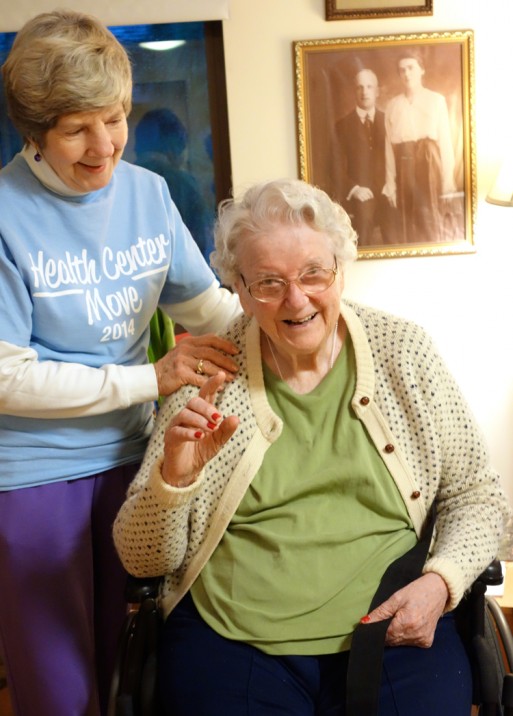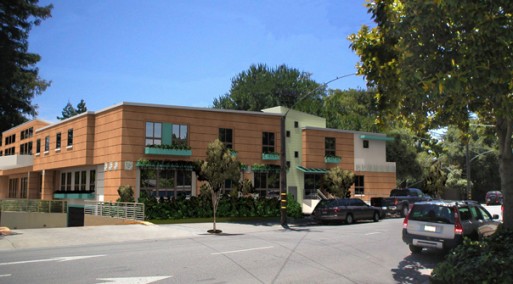
Ann and her “Buddy”
Ann Clark has a playful light in her blue-green eyes. Now in her seventies, her exuberant presence is inviting, and you just want to be her friend. Ann’s zest for life shines even through the countless hours spent by the beds of her clients and friends. As a Geriatric Care Manager at Channing House and a member of a vigil group of volunteers who assist the health center residents through the dying process, Ann keeps a busy schedule by offering person-centered attention and friendship to the members of her community who are approaching the end of life.
Raised in a supportive family, Ann was inspired by her physician father to go into the field of medicine. After completing her undergraduate studies at Stanford, she worked in the field of clinical research as well as sales and marketing of surgical capital equipment. Later in her career, inspired by a Stanford classmate who had earned her PhD at the Institute for Transpersonal Psychology, Ann completed her masters in the same field. Drawing from the discipline’s holistic, spiritual approach to psychology, Ann combined her medical background with a certification in clinical massage therapy and found her calling as a massage therapist “nurturing to the whole person, body, mind and spirit.” Having retired, Ann, now a volunteer, continues to nurture the souls of those aging and approaching death.

The New Health Center
(Credit: Nibbi.com)
While still working as a massage therapist at the Sequoias of Portola Valley and at Channing House, two well-respected life care retirement communities in the San Francisco Bay Area, Ann began taking on a much bigger role: she became a friend to her clients, as well as a liaison between them and their families. From driving her clients to doctors’ visits and giving their adult children and them the detailed health reports of those visits, to stimulating the minds of her elderly friends through music, poetry and most importantly — friendship — Ann found herself providing a service referred to as Geriatric Care Management. Even though she wasn’t certified in Elder Care, her compassionate and comprehensive approach made her very much in demand and soon her client base included private homes, retirement communities and even hospitals.
When Ann herself decided to move to Channing House in 2013, she already had a “built in group of friends” which made it easier for her to transition to her new lifestyle. During that time, a new health center was being built to house the assisted living and skilled nursing wing of Channing House. Ann joined a group of volunteers who helped to facilitate the upcoming move into the new health center. Ann began to spend time in the old health center: singing, reading and becoming what the volunteers called “Buddies” with the patients. In 2014, when it was time to move, the volunteers knew their Buddies so well they were able to arrange their furniture and personal belongings in their new spaces to duplicate their old rooms to ease their Buddies into their new surroundings.
“We want people to make their own decisions after well-informed discussion with their families and legal and medical advisers so at the end they will be able to have their own choice of how to die.” — Ann Clark
As a member of the vigil group, Ann spends time with residents expected to die within 24-48 hours. The vigil volunteers are called on by the Director of Health Services to be with the dying person until their family arrives. Vigil volunteers, who may already have had close relationships with their Buddies, assist them by playing their favorite CDs, holding the dying friend’s hand or simply by sitting by their side. “Others like us to just let them know we are with them by our voices and warm presence. You can tell by listening, watching, intuiting what is needed,” Ann explains. This work does not end when the family arrives. The volunteers give respite time to the family as they locate places to stay, eat or do business in the area. “As I say, it’s very individual and works because those who volunteer for the Vigil group are comfortable with death and dying,” she adds.

The Channing House in Palo Alto
(Credit: Yelp.com)
Also at Channing House, Ann is a member of a larger group currently developing “The End of Life” series to help seniors open a discussion about dying and preparing for the end of life. Ann stresses the need for discussing medical, legal, social and spiritual concerns before the end. “Much literature exists and anecdotal stories abound of how people have thought they had legal documents that would assure them a peaceful death, when in fact doctors, paramedics, nurses and hospitals as institutions have the expectation and mandate by law to ‘save’ people even against their will.” To help people die in a way that’s fitting for each individual, Ann advises seniors, in addition to Durable Power of Attorney for Health Care, to complete a new form: POLST (Physician Orders for Life Sustaining Treatment) with their physicians. “We want people to make their own decisions after well-informed discussion with their families and legal and medical advisers so at the end they will be able to have their own choice of how to die,” she says.
“As I say, it’s very individual and works because those who volunteer for the Vigil group are comfortable with death and dying.” — Ann Clark
Over the years, Ann has seen changes in societal views towards death. There are new laws, such as the “Right to Die” in Oregon, Washington, Montana, Vermont and New Mexico and now one is in the process of being presented to the legislature in California. Compassion and Choices is an organization that educates young and old across the country about choices they have at the end of life. “The difficult part comes when a senior wants to have ‘The Talk’ (about what one wants at the end) with the adult children who are reluctant to discuss it, or vice versa.” Ann also feels that we all can help to start a conversation on the importance of making one’s own end-of-life choices by attending end-of-life programs, writing articles, blogging and circulating that information through the media. A recent and significant news report from Canada may show positive precedent as legislation is presented in many states in the United States.
Throughout her experience, Ann came across many different attitudes towards death from “just take me out and shoot me” to careful planning to circumvent any medical interference. “I don’t want to talk about it” is a comment she had encountered only once. As the discussion of dying becomes less and less taboo, Ann strives to embrace the end of life by helping her friends and clients have choices in death as they had in life and by providing a tranquil, compassionate shoulder to the dying and to their bereaved families. Her strength comes from an active participation in life and from a calm acceptance of death.

 A Friend in Life and Death
A Friend in Life and Death



 Composting Bodies Is Now Legal in a Dozen States
Composting Bodies Is Now Legal in a Dozen States
 “Hand to Earth” by Andy Goldsworthy
“Hand to Earth” by Andy Goldsworthy














